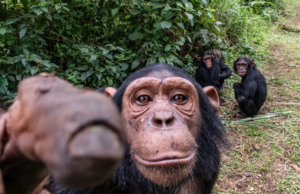Computer facial recognition to combat wildlife trafficking. Starting with our fellows chimpanzees. ChimpFace arises!
 Caption: ||||Billy é um dos chimpanzés que vivem no Santuário de Grandes Primatas de
Caption: ||||Billy é um dos chimpanzés que vivem no Santuário de Grandes Primatas de
By Jaqueline B. Ramos*
Wildlife trafficking is a multibillion-dollar illegal trade and currently buyers and sellers openly use internet social media to do their dirty business. Fortunately a lot of people are dedicated to its combat in different ways, including computer learning experts.
For two years, a project led by North-American conservationist Alexandra Russo and Dr. Colin McCormick, Senior Technical Advisor at Conservation X Labs, has been developing a facial recognition software which will be able not only to recognize if photos published in the internet contain chimpanzees, but also identify which individual chimpanzee is in each image, which will become an essential tracking tool to combat the illegal trade.
The project was named ChimpFace and in November 2018, during the Conservation X Labs Con X Tech Prize, it was one of the finalists with its preliminary prototype developed.
“I thought about this software after I started helping Dr. Dan Stiles in Pegas – Project to end Great Ape Slavery. I very quickly realized that looking for criminals on line was actually incredible tedious, because it’s like looking a needle in a haystack, among hundreds and thousands of photos on the internet. It came to my mind there could be a better way to do it and I started reaching out to computer learning experts asking if developing an algorithm to recognize great apes in images was even something in the realm of possibility. And luckily they said yes, that it was only necessary to choose one to begin”, tells Russo.
In fact, the technology behind ChimpFace is very similar to the one applied in image recognition programs already used by Police forces for other types of crimes. For ChimpFace to arise, it was necessary to work with photos of known chimpanzees for the development of the algorithm.

The idea of the software was then presented for nine conservation and great apes organizations (Centre de Conservation pour Chimpanzez/Project Primate International, Chimpanzee Sanctuary Northwest, Duke University, GAP Project Brazil, Jane Goodall Institute, Save the Chimps Sanctuary, Sweetwaters Chimpanzee Sanctuary, Tacugama Chimpanzee Sanctuary and Liberia Chimpanzee Rescue and Protection), which, naturally, became fundamental supporters of ChimpFace, providing images of captive chimpanzees who currently live in sanctuaries – and also a few photos of wild chimpanzees.
“The more images we get, the more accurate we can build it up to be. It still needs to be improved a lot, but we have started. And we are really excited!”, highlights Russo.

Billy is one of the chimpanzees who lives at Great Apes Sanctuary in Sorocaba/Brazil, affiliated to GAP Project, and is one of the “volunteers”of face images for the development of ChimpFace
Chimp Face in the future
According to Russo, the original idea was that ChimpFace would turn into an app. But then it was decided to start simple and more effective. ”Microsoft has granted us cloud computation credits, which we will use to deploy the software. The first step of the development is the binary classifier, which is training an algorithm to recognize in any public available material either the image is of a chimpanzee or not”, explains Russo, pointing that this partially automation of the currently manual search process will already save a tremendous amount of time and money.

The second layer of ChimpFace, which requires exponentially more work, is training the algorithm to recognize individual faces, so the movement of an individual can be tracked both on line and live, when the chimpanzee is found in facilities in different countries.
Russo says this is where the project wants to get to the point of. Not to mention other useful applications for ChimpFace in the future (check box in the end), like monitoring the trade of live captive chimpanzees and even study wild chimpanzees populations.
Reaching such big goals will surely require expressive fundings sources, to pay for development staff time. But the conservationist is optimistic about it. “In a dreamworld, a technology or social media company could incorporate ChimpFace into their systems, as long as they routinely monitor for some crimes. Why don’t just add this to the level of policing already done?”, proposes Russo. “I’m sure the time is very fortunate because both wildlife trafficking and artificial intelligence (AI) are getting a lot of attention. AI is being advertised a lot. So it’s appropriate to bring the fight against illegal wildlife poaching to the attention of big companies”, concludes.
Read more about ChimpFace in https://conservationx.com/project/id/8.
*Journalist and Communications Manager of GAP Project International

Read more about ChimpFace at:
BBC – https://www.bbc.com/news/science-environment-46945302
Fast Company – https://www.fastcompany.com/90292089/facial-recognition-for-chimps-searches-the-internet-for-stolen-baby-apes

 Español
Español
 Português
Português








